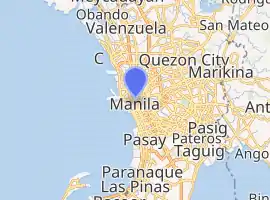Puente Colgante (Manila)
The Puente Colgante, originally called Puente de Clavería, was a suspension bridge that connected the Manila districts of Quiapo and Ermita across the Pasig River in the Philippines. Designed by Spanish engineer Matias Menchacatorre and completed in 1852, it was the first wire-cable suspension bridge in Asia and the first toll bridge of its kind in the Philippines.[1] It was replaced by Quezon Bridge in 1939.
Puente Colgante | |
|---|---|
 Puente de Clavería as seen on October 1, 1875. | |
| Coordinates | 14°35′43.8″N 120°58′55.5″E |
| Carries | Pedestrians and carriages |
| Crosses | Pasig River |
| Locale | Manila |
| Other name(s) | Clavería Bridge (before 1930s) |
| Preceded by | Puente de Convalecencia (1880) |
| Followed by | Puente Grande (1852) Puente de España (1875) Jones Bridge (1916) |
| Characteristics | |
| Design | Suspension bridge |
| Material | Steel structure, wooden deck |
| Total length | 110 m (360 ft) |
| Width | 7 m (23 ft) |
| No. of spans | One |
| Piers in water | None |
| History | |
| Designer | Matias Mechacatorre |
| Constructed by | Ynchausti y Compañia |
| Construction start | 1849 |
| Construction end | 1852 |
| Opened | January 4, 1852 |
| Replaced by | Quezon Bridge (1939) |
| Location | |

| |
History
Puente Colgante (which is the term for a suspension bridge in Spanish; literally, hanging bridge), the second bridge built over Pasig river, was the first steel suspension bridge built in Asia when it was completed in 1852.[1] It was built and owned by Ynchausti y Compañia, the business headed by Jose Joaquín de Ynchausti.[2] He commissioned the wire-cable suspension design from Spanish-Basque engineer Matias Menchacatorre.[3] The bridge was first named Puente de Clavería, likely in honor of the Governor-General of the Philippines Narciso Clavería, who served from 1844-1849.
The suspension bridge measured 110 meters (360 ft) long and 7 meters (23 ft) wide, and had two lanes that allowed passage of horses and carabao-drawn carriages. It was also opened for pedestrians traveling on foot between Quiapo and Intramuros and nearby areas.
In 1854 Ynchausti brought together the Ynchausti family holdings under the above name. A Basque Spaniard born in Cadiz, de Ynchausti migrated to the Philippines in the second quarter of the nineteenth century and built a business empire.[2] In 1889 Ynchausti y Compañia was the largest company in the Philippines.
The 20th-century Filipino writer Nick Joaquin described the bridge as it was in the 1870s: “Across the city’s river now arched … the amazing Puente Colgante, suspended in the air, like a salute to the age of science and engineering. The Industrial Age found its expression in the Philippines in the form of a bridge unparalleled throughout Asia.”[3] Historians dispute local traditions that say the bridge was designed by Gustave Eiffel, who designed the Eiffel Tower in Paris. (This is also asserted about the Puente de Ayala.) They note the original bridge has been documented as designed by a Basque.[3] (In addition, the 1930s work was performed a decade after Eiffel died in 1923.)
Puente Colgante was later replaced by Quezon Bridge in the 1930s.
References
- Noche, Manolo (April 5, 2006). "Bridge Over Not So Troubled Waters: Spanning Communities and Building Relationships". ICOMOS Philippines. Retrieved September 11, 2014.
- Marciano R. de Borja, Basques in the Philippines, University of Nevada Press, 2005, p. 132, accessed 20 January 2011
- Alejandro R. Roces, "One of the symbols of 19th century Manila was its Hanging Bridge built and owned by Basques", Euskacultura